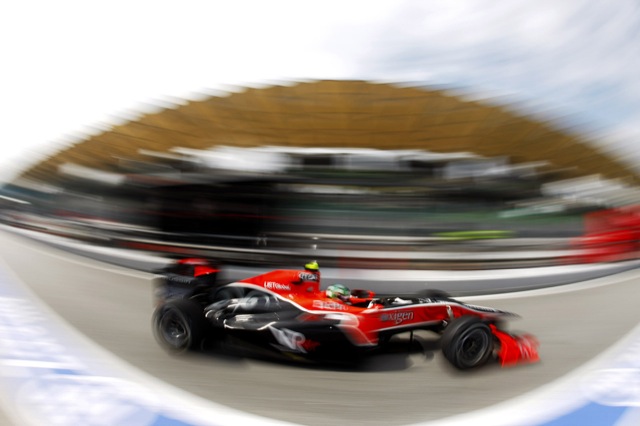During yesterday’s pre-British Grand Prix test at Silverstone, Giancarlo Fisichella suffered a fairly sizable impact at the Becketts Complex in his Force India. While testing out some modifications to the car, it would seem as though the Italian was caught by a strong gust of wind that unstabilised the car and led to an impact with the barrier. Fisichella was taken to hospital for checks, and although the previous grand prix winner said he was fine, the medics paid particular attention to his wrists: Giancarlo did not take his hands off the steering wheel.
So why should you take your hands off the steering wheel if you heading uncontrollably towards a barrier in a Formula One car? Surely it goes against natural instinct to want to bring the car under control before an impact, hopefully avoiding contact with anything other than the ground. But drivers often release their grip when they know they are no more than a passenger and there is little more they can do to prevent an accident.
The reason for this somewhat dismissive attitude towards car control is down to preserving the hands, fingers and wrists. When a driver turns the steering wheel of an F1 car, the front two wheels turn accordingly. However, if you were able to jack the car up and turn the wheels, guess what happens to the steering wheel? Yep, it will spin around. Under normal circumstances, there is little reason to want to do this, but when a car ploughs into a barrier, normal circumstances are thrown out of the window.
The impact of the front wheels into a barrier can violently snap the steering wheel around. If a drivers thumb is looped over the grip and his hands generally near the wheel, bones can very easily be broken, from fingers and thumbs to wrists. When Heikki Kovalainen went off during the Spanish Grand Prix earlier in the season, the video clearly shows the Finn releasing his grip moments before impact. And just as well to be fair, as after being checked out overnight in hospital, the McLaren driver walked away with no broken bones and just a minor concussion.
Further more to taking your hands off the wheel, drivers are encouraged to rest their hands on the top of their thighs and relax. I’m not entirely sure just how possible it is to relax moments before clouting a wall at 150mph, but then I’m not a racing driver. But relaxing the body helps limit injury and allow the energy to move better through the driver and car, apparently.
So there you have it. The reason why Fisichella was taken off to hospital for a check-up yesterday was because he failed to let go of the steering wheel and may have damaged his wrists. Thankfully the veteran of more than 200 races is fine, but will rest today and let team mate Adrian Sutil take the reins of the VJM01.
Update:
When I wrote this post earlier today I was hoping to use the video of Kovalainen’s accident to highlight a driver taking his hands off the wheel. But being a recent clip Bernie and his Band (FOM) have taken it down. However, with thanks to Bill Adkins (who will be making another appearance soon) we have a link to another incident where it is clear to see what a driver is doing with his hands. See, I do read my emails from time to time. 😛
The incident was the European Grand Prix in 2005, and the situation was Kimi Raikkonen in the McLaren doing what every good racing driver does – continue driving no matter what. And here he is with a badly flat-spotted tyre. With only a few laps left though the Finn has to continue, and the vibrations finally rip the suspension apart heading out of the first sequence of corners. After spinning around and just about kissing the backside of Button, Kimi releases his hands and waits for impact. At 1 minute 45 seconds or so you get to see the incident from the onboard camera and the steering wheel hack-sawing around, thankfully without his hands on it.
Image © HondaF1.


















[…] White de BlogF1 tiene un interesante artículo de por qué los pilotos sacan las manos del guía momentos antes de impactar en un auto de Fórmula […]
Looks to me like this position is the best for any driver (F1 or road car)when the crash is unavoidable. Cross your arms over your chest is not only to protect your precious hands but also to protect your chest from… the steering wheel! flex your legs (like when landing after a parachute jump) to avoid breaking your knees and to use your leg’s muscles as shock-absorbers, bend your head and “round” your back as a “stretched” backbone is more likely to cause bad injuries…
Can’t remember exactly but I think I learned that a long time ago in some kind of training…
[…] Why Drivers Take Their Hands Off The Wheel In An Accident: Following an accident Giancarlo Fisichella suffered while testing, I took a few moments to explain something odd that happens in the event of a crash. […]